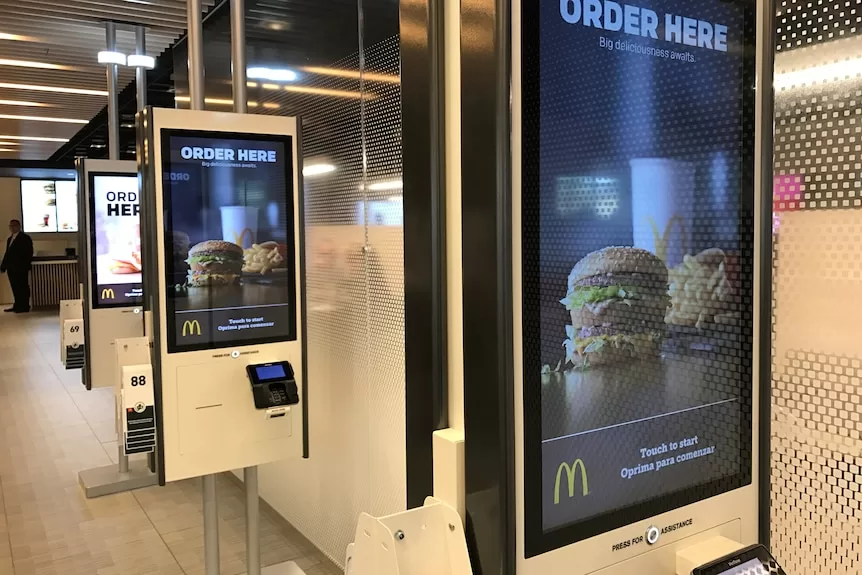- In short: McDonald’s suffered a global systems outage on Friday evening, causing restaurants across Australia to turn away customers.
- The tech troubles are unlikely to slow the fast-food giant’s adoption of new technology, including artificial intelligence.
- What’s next? McDonald’s is continuing to push for more customers to order through digital avenues like its app and its self-serve kiosks.
When McDonald’s first opened for business in the 1940s, its workers stood at physical counters, its burgers and fries were listed on paper menus, and its customers paid cash to its human cashiers.
Today technology so infuses every aspect of McDonald’s business that it would only be a slight exaggeration to call it a tech company that happens to sell burgers.
McDonald’s mobile app; its human-less, order-taking kiosks; its digitised menus that change based on trends, the weather and more; and even its generative AI — together, these enable McDonald’s to eke out additional sales and efficiencies worth billions of dollars to the company, which has 40,000 locations in roughly 100 countries.
Yet that same technology can also bring McDonald’s to its knees.
On Friday evening, system outages plagued McDonald’s restaurants across Australia and in other countries including Japan and the United Kingdom, forcing many stores to temporarily take only cash or shut down entirely.
The company hasn’t disclosed how widespread the outages were, but early Saturday morning Australian time, about 12 hours after the outages were first reported, a franchise in San Antonio, Texas couldn’t accept orders in its app and wouldn’t accept cash.
McDonald’s said in a statement the outage was caused by an unnamed third-party provider during a “configuration change”.
McDonald’s Australia on Friday evening apologised to customers for the inconvenience, and added that the issue was “not related to a cybersecurity event”.
Tech outage unlikely to slow new strategy
The fast-food giant did flag that something like this could happen, at least to Wall Street.
“We are increasingly reliant upon technology systems,” company lawyers wrote in its annual Securities and Exchange Commission filing on February 22.
“Any failure or interruption of these systems could significantly impact our or our franchisees’ operations, or our customers’ experiences and perceptions.”
Even AI gets a warning in the filing, which states that “the artificial intelligence tools we are incorporating into certain aspects of our restaurant operations may not generate the intended efficiencies and may impact our business results”.
Yet Friday’s widespread outage is unlikely to bump McDonald’s out of its long-term strategy to deepen its reliance on tech.
The company wants more customers to order through digital avenues like its app and its self-serve kiosks, which already made up a third of its sales in top markets in 2022.
In December, McDonald’s announced a partnership with Google to move restaurant computer systems into the cloud, where the global scale of data will allow McDonald’s generative AI system to “better understand the broadest range of patterns and nuances”, resulting in what McDonald’s at the time said would be “hotter, fresher food”.
Generative AI already powers much of the restaurant operations and personalised pitches made from internal profiles of customers.
New tech accelerates across the board
It’s not just McDonald’s. Technology is the flavour of the day for virtually every major fast food chain.
Starbucks in 2019 announced its own internal AI platform, called “Deep Brew”, which then-CEO Kevin Johnson said would increasingly power its personalised offers, store staffing and inventory management.
“Over the next 10 years, we want to be as good at AI as the tech giants,” Mr Johnson told a retail conference in 2020, according to Retail Dive, a trade publication.
Starbucks in 2022 hired a former McDonald’s executive to oversee its use of technology.
Risks from this new technology don’t just come from system outages.
American burger chain Wendy’s received public backlash after its CEO said during an earnings call in mid-February that the chain would soon use “dynamic pricing” on its digital signs — yet another technology that would not have been possible before the age of information.
The chain later clarified that it did not intend to use digital signs to implement “surge pricing” that could let it charge higher prices during busy times.
Rather, Wendy’s said, its CEO’s remarks referred to its plan to offer discounts to patrons during slow parts of the day.
Reuters
